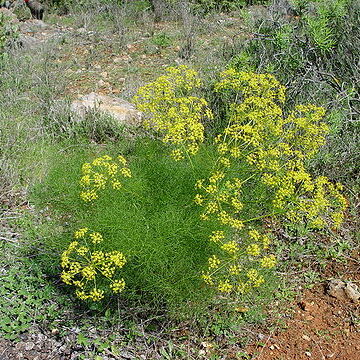Herbs, annual or perennial, all parts strongly aromatic (anise-scented). Stem erect, terete, gray-green or lurid-green, glabrous. Leaves petiolate, sheaths membranous-margined; blade pinnately decompound; ultimate segments linear. Umbels compound, terminal and lateral; bracts and bracteoles absent; rays numerous, upwards-spreading, unequal. Calyx teeth obsolete. Petals yellow, obovate, mid rib conspicuous, apex with narrowly inflexed lobule. Stylopodium conic; styles very short, reflexed. Fruit oblong, terete, glabrous; ribs 5, acute or round-obtuse; vittae 1 in each furrow, 2 on commissure. Seed face plane or slightly concave. Carpophore 2-cleft to base.
Fr oblong, slightly flattened laterally or subterete, the ribs slender but prominent; oil-tubes solitary in the intervals, 2 on the commissure; carpophore bifid to the base; umbels large, compound, on stout peduncles; invol and involucel none; umbellets numerous; sep none; pet yellow; stylopodium conic; coarse perennials with the lvs dissected into linear or filiform segments. 5, Europe and Medit. reg.
Glabrous, biennial or perennial herbs, with taproots. Lvs 3-5-pinnate; segments filiform. Umbels compound, pedunculate; bracts and bracteoles 0. Petals yellow, regular, with entire, obtuse, inflexed apex; calyx teeth 0. Fr. ovoid-oblong, terete, not beaked, spineless; commissure broad; ribs 5 per mericarp, stout, the lateral somewhat broader; vittae solitary in furrows.
Fruit narrowly ovoid, very slightly laterally compressed; ribs fairly robust and obvious at maturity.
Biennial or perennial herbs with pinnately divided leaves, with filiform ultimate segments.
Umbels compound, bracts and bracteoles 0–few.
Petals yellow with strongly inturned apices.
Vittae solitary in the furrows.
Sepals absent.

